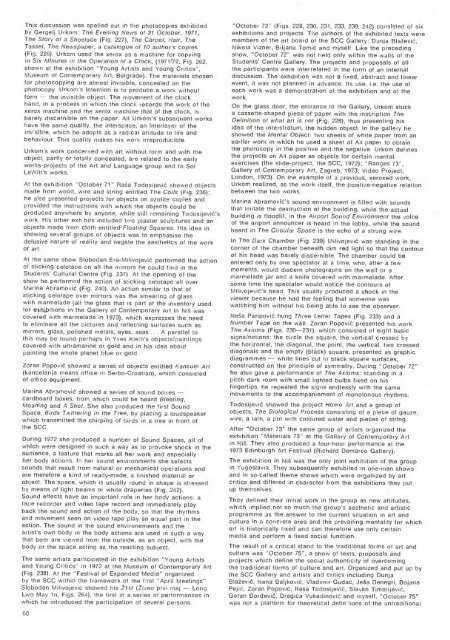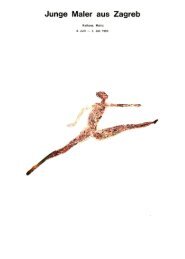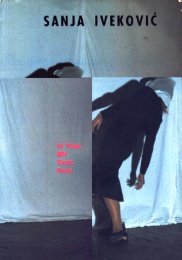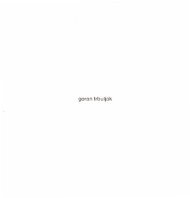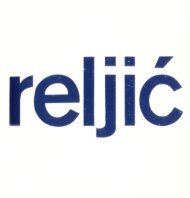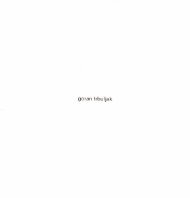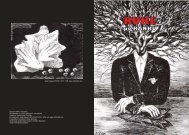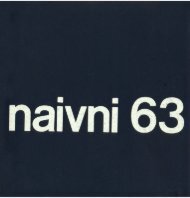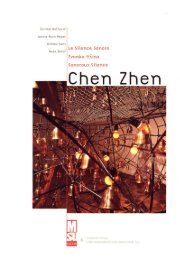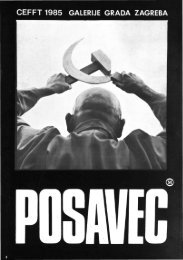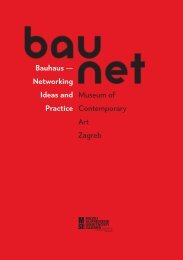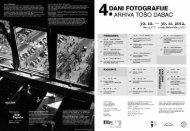The New Art Practice in Yugoslavia, 1966-1978
The New Art Practice in Yugoslavia, 1966-1978
The New Art Practice in Yugoslavia, 1966-1978
- TAGS
- practice
- yugoslavia
- www.msu.hr
You also want an ePaper? Increase the reach of your titles
YUMPU automatically turns print PDFs into web optimized ePapers that Google loves.
This discussion was spelled out <strong>in</strong> the photocopies exhibited<br />
by Gergelj Urkom: <strong>The</strong> Even<strong>in</strong>g <strong>New</strong>s of 31 October, 1971,<br />
<strong>The</strong> Story of a Shoelace (Fig. 227), <strong>The</strong> Carpet, Hair, <strong>The</strong><br />
Tassel, <strong>The</strong> <strong>New</strong>spaper, a catalogue of 10 author's copies<br />
(Fig. 226). Urkom used the xerox as a mach<strong>in</strong>e for copy<strong>in</strong>g<br />
<strong>in</strong> Six M<strong>in</strong>utes <strong>in</strong> the Operation of a Clock, (1971 72, Fig. 262,<br />
shown at the exhibition "Young <strong>Art</strong>ists and Young Critics",<br />
Museum of Contemporary <strong>Art</strong>, Belgrade). <strong>The</strong> materials chosen<br />
for photocopy<strong>in</strong>g are almost <strong>in</strong>visible, concealed on the<br />
photocopy. Urkom's <strong>in</strong>tention is to produce a work without<br />
form the <strong>in</strong>visible object. <strong>The</strong> movement of the clock<br />
hand, <strong>in</strong> a process <strong>in</strong> which the clock records the work of the<br />
Xerox mach<strong>in</strong>e and the xerox mach<strong>in</strong>e that of the clock, is<br />
barely discernible on the paper. All Urkom's subsequent works<br />
have the same quality, the <strong>in</strong>terspace, an <strong>in</strong>terlayer of the<br />
<strong>in</strong>v'sible, which he adopts as a radical attitude to life and<br />
behaviour. This quality makes his work irreproducible.<br />
Urkom's work concerned with art without form and with the<br />
object, partly or totally concealed, are related to the early<br />
works-projects of the <strong>Art</strong> and Language group and to Sol<br />
LeWitt's works.<br />
At the exhibition "October 71" Raa Todosijevi showed objects<br />
made from wood, wire and str<strong>in</strong>g entitled <strong>The</strong> Coils (Fig. 236);<br />
he also presented projects for objects on ozolite copies and<br />
provided the <strong>in</strong>structions with which the objects could be<br />
produced anywhere by anyone, while still rema<strong>in</strong><strong>in</strong>g Todosijevi's<br />
work His other exh.bits <strong>in</strong>cluded two plaster sculptures and an<br />
objects made from cloth entitled Float<strong>in</strong>g Squares. His idea <strong>in</strong><br />
show<strong>in</strong>g several groups of objects was to emphasise the<br />
delusive nature of reality and negate the aesthetics of the work<br />
of art.<br />
At the same show Slobodan Era-Milivojevi performed the action<br />
of stick<strong>in</strong>g celotape cn all the mirrors he could f<strong>in</strong>d <strong>in</strong> the<br />
Students' Cultural Centre (Fig. 237). At the open<strong>in</strong>g of the<br />
show he performed the action of stick<strong>in</strong>g celotape all over<br />
Mar<strong>in</strong>a Abramovi (Fig. 240). An action similar to that of<br />
stick<strong>in</strong>g celotape over mirrors was the smear<strong>in</strong>g of glass<br />
with marmelade (all the glass that is part of the <strong>in</strong>ventory used<br />
for exhibitions <strong>in</strong> the Gallery of Contemporary <strong>Art</strong> <strong>in</strong> Ni was<br />
covered with marmelade <strong>in</strong> 1973), which expresses the need<br />
to elim<strong>in</strong>ate all the pictures and reflect<strong>in</strong>g surfaces such as<br />
mirrors, glass, polished metals, eyes, seas ... A parallel to<br />
this may be found perhaps <strong>in</strong> Yves Kle<strong>in</strong>'s objects/pa<strong>in</strong>t<strong>in</strong>gs<br />
covered with ultramar<strong>in</strong>e or gold and <strong>in</strong> his idea about<br />
pa<strong>in</strong>t<strong>in</strong>g the whole planet blue or gold.<br />
Zoran Popovi showed a series of objects entitled Kancum <strong>Art</strong><br />
(kancelarija means office <strong>in</strong> Serbo-Croatian), which consisted<br />
of office equipment.<br />
Mar<strong>in</strong>a Abramovi showed a series of sound boxes<br />
cardboard boxes, from which could be heard Bleet<strong>in</strong>g,<br />
Moan<strong>in</strong>g and A Shot. She also produced the first Sound<br />
Space. Birds Twitter<strong>in</strong>g <strong>in</strong> the Tree. by plac<strong>in</strong>g a loudspeaker<br />
which transmitted the chirp<strong>in</strong>g of birds <strong>in</strong> a tree <strong>in</strong> front of<br />
the SCC.<br />
Dur<strong>in</strong>g 1972 she produced a number of Sound Spaces, all of<br />
which were designed <strong>in</strong> such a way as to provoke shock <strong>in</strong> the<br />
audience, a feature that marks all her work and especially<br />
her body actions. In her sound environments she selects<br />
sounds that result from natural or mechanical operations and<br />
are therefore a k<strong>in</strong>d of ready-made, a f<strong>in</strong>ished material or<br />
object. <strong>The</strong> space, which is usually round <strong>in</strong> shape is stressed<br />
by means of light beams or while draperies (Fig. 242).<br />
Sound effects have an important role <strong>in</strong> her body actions: a<br />
tape recorder and video tape record and immediately play<br />
back the sound and action of the body, so that the rhythms<br />
and movement seen on video tape play an equal part <strong>in</strong> the<br />
action. <strong>The</strong> sound <strong>in</strong> the sound environements and the<br />
artist's own body <strong>in</strong> the body actions are used <strong>in</strong> such a way<br />
that both are viewed from the outside, as an object, with the<br />
body or the space act<strong>in</strong>g as the react<strong>in</strong>g subject.<br />
<strong>The</strong> same artists participated <strong>in</strong> the exhibition "Young <strong>Art</strong>ists<br />
and Young Critics" <strong>in</strong> 1972 at the Museum of Contemporary <strong>Art</strong><br />
(Fig. 238). At the -Festival of Expanded Media" organized<br />
by the SCC with<strong>in</strong> the framework of the f. rst "April Meet<strong>in</strong>gs"<br />
Slobodan Milivojevi showed his 21M (Ziveo prvi maj Long<br />
Live May 1n, Figs. 264), the first <strong>in</strong> a series of performances <strong>in</strong><br />
which he <strong>in</strong>troduced the participation of several persons.<br />
60<br />
"October 72" (Figs. 228, 230, 231, 233, 239, 242) consisted of six<br />
exhibitions and projects. <strong>The</strong> authors of the exhibited texts were<br />
members of the art board of the SCC Gallery: Dunja Blaevi,<br />
Nikola Vizner, Biljana Tomi and myself. Like the preced<strong>in</strong>g<br />
show, "October 72" was not held only with<strong>in</strong> the walls of the<br />
Students' Centre Gallery. <strong>The</strong> projects and proposals of all<br />
the participants were <strong>in</strong>terrelated <strong>in</strong> the form of an <strong>in</strong>ternal<br />
discussion. <strong>The</strong> exhibition was not a fixed, abstract and l<strong>in</strong>ear<br />
event, it was not planned <strong>in</strong> advance. Its use, i.e. the use of<br />
each work was a demonstration of the exhibition and of the<br />
work.<br />
On the glass door, the entrance to the Gallery. Urkom stuck<br />
a cassette-shaped piece of paper with the <strong>in</strong>scription <strong>The</strong><br />
Def<strong>in</strong>ition of what art is not (Fig. 228), thus present<strong>in</strong>g his<br />
idea of the <strong>in</strong>terstratum, the hidden object. In the gallery he<br />
showed the Mental Object.' two sheets of white paper from an<br />
earlier work <strong>in</strong> which he used a sheet of A4 paper to obta<strong>in</strong><br />
the photocopy <strong>in</strong> the positive and the negative. Urkom def<strong>in</strong>es<br />
the projects on A4 paper as objects for certa<strong>in</strong> mental<br />
exercises (the slide-project, the SCC, 1972): "Ranges 73",<br />
Gallery of Contemporary <strong>Art</strong>, Zagreb, 1973: Video Project,<br />
London, 1973). On the example of a previous, xeroxed work,<br />
Urkom realized, as the work itself, the positive-negative relation<br />
between the two works.<br />
Mar<strong>in</strong>a Abramovi's sound environment is filled with sounds<br />
that imitate the destruction of the build<strong>in</strong>g, while the actual<br />
build<strong>in</strong>g is floodlit; <strong>in</strong> the Airport Sound Environment the voice<br />
of the ariport announcer is heard n the lobby, while the sound<br />
heard <strong>in</strong> <strong>The</strong> Circular Space is the echo of a strung wire.<br />
In <strong>The</strong> Dark Chamber (Fig. 239) Milivojevi was stand<strong>in</strong>g <strong>in</strong> the<br />
corner of the chamber beneath dim red light so that the contour<br />
of his head was barely discernible. <strong>The</strong> chamber could be<br />
entered only by one spectator at a time, who, after a few<br />
moments, would discern photographs on the wall or a<br />
marmelade jar and a knife covered with marmelade. After<br />
some time the spectator would notice the contours of<br />
Milivojevi's head. This usually produced a shock <strong>in</strong> the<br />
viewer because he had the feel<strong>in</strong>g that someone was<br />
watch<strong>in</strong>g him without his be<strong>in</strong>g able to see the observer.<br />
Nea Paripovi hung Three Letter Tapes (Fig. 233) and a<br />
Number Tape on the wall. Zoran Popovi presented his work<br />
<strong>The</strong> Axioms (Figs. 230-231), which consisted of eight basic<br />
signs/notions: the circle the square, the vertical crossed by<br />
the horizontal, the diagonal, the po<strong>in</strong>t, the vertical, two crossed<br />
diagonals and the empty (black) square, presented as graphic<br />
diagrammes white l<strong>in</strong>es cut <strong>in</strong> black square surfaces,<br />
constructed on the pr<strong>in</strong>ciple of symmetry. Dur<strong>in</strong>g "October 72"<br />
he also gave a performance of <strong>The</strong> Axioms: stand<strong>in</strong>g <strong>in</strong> a<br />
pitch dark room with small lighted bulbs fixed on his<br />
f<strong>in</strong>gertips, he repeated the signs endlessly with the same<br />
movements to the accompaniement of monotonous rhythms.<br />
Todosijevi showed the project Homo <strong>Art</strong> and a group of<br />
objects, <strong>The</strong> Biological Process consist<strong>in</strong>g of a piece of gauze.<br />
wire, a lath, a pot with coloured water and pieces of str<strong>in</strong>g.<br />
After "October 73" the same group of artists organized the<br />
exhibition "Materials 73" at the Gallery of Contemporary <strong>Art</strong><br />
<strong>in</strong> Ni. <strong>The</strong>y also produced a four-hour performance at the<br />
1973 Ed<strong>in</strong>burgh <strong>Art</strong> Festival (Richard Demarco Gallery).<br />
<strong>The</strong> exhibition <strong>in</strong> Ni was the only jo<strong>in</strong>t exhibition of the group<br />
<strong>in</strong> <strong>Yugoslavia</strong>. <strong>The</strong>y subsequently exhibited <strong>in</strong> one-man shows<br />
and <strong>in</strong> so-called theme shows which were organized by art<br />
critics and differed <strong>in</strong> character from the exhibitions they put<br />
up themselves.<br />
<strong>The</strong>y def<strong>in</strong>ed their <strong>in</strong>itial work <strong>in</strong> the group as new attitudes,<br />
which implied not so much the group's aesthetic and artistic<br />
programme as the answer to the current situation <strong>in</strong> art and<br />
culture <strong>in</strong> a concrete area and the prevail<strong>in</strong>g mentality for which<br />
art is historically fixed and can therefore use only certa<strong>in</strong><br />
media and perform a fixed social function.<br />
<strong>The</strong> result of a critical stand to the traditional forms of art and<br />
culture was "October 75", a show of texts, proposals and<br />
projects which def<strong>in</strong>e the social authenticity of overcom<strong>in</strong>g<br />
the traditional forms of culture and art. Organized and put up by<br />
the SCC Gallery and artists and critics <strong>in</strong>clud<strong>in</strong>g Dunja<br />
Blaevi, Nena Baljkovi, Vladimir Gudac, Jea Denegri, Bojana<br />
Peji, Zoran Popovi, Raa Todosijevi, Slavko Timotijevi,<br />
Goran Dordevi, Dragica Vukad<strong>in</strong>ovi and myself, "October 75"<br />
was not a platform for theoretical def<strong>in</strong>tions of the untraditional


